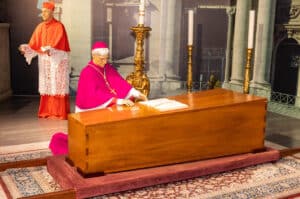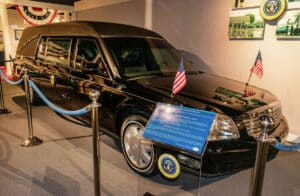While not a favorite topic for discussion, “death care is one of man’s oldest professions,” according to Robert L. Waltrip, an undertaker turned collector on the topic. In 1992, Waltrip founded the National Museum of Funeral History in Houston, Texas to “educate the public and preserve the heritage” of this important aspect of life, loss, and mourning. Today, his 30,500-square-foot museum is the largest of its kind, housing the most funerary artifacts in the world.
The idea for the Museum grew from Waltrip’s 25-year dream of establishing an institution to house, preserve, and display the older tools of his trade he and his family had collected over their decades in the funeral services industry; items Waltrip realized were otherwise being discarded. What started as a way to house his own funerary items has since evolved into a rich cultural experience for the
thousands who visit, says Genevieve Keeney, the museum’s president, and CEO.

The Museum’s first major exhibit was a collection of vintage hearses, which continues to expand and fascinate visitors. In 2005, the Museum began its collaboration with the Vatican for what has become its hallmark exhibit, Celebrating the Lives and Deaths of the Popes. A collection of authentic items was acquired by the Museum for display, including the original uniforms worn by The Swiss Guard (responsible for the Pope’s personal security) and vestments from Gammarelli’s, the tailor shop in Rome, which has clothed the last seven Popes. A 10,000-square-foot expansion of the Museum took place to accommodate the 5,000-square-foot exhibit, which opened in 2008, featuring premium sound and lighting, three-dimensional scenes, and audio/visual multi-media presentations providing visitors with a true sense of attending a Pope’s funeral and the sacred traditions that are observed when a pope dies.
Over the decades, the museum has been able to expand its permanent exhibits through generous donations and acquisitions of significant items that document the history of the industry. Today, 17 permanent exhibits tell the stories behind a broad spectrum of funeral-related topics, ranging from the ancient embalming rituals of Egypt to remembering celebrities and public figures.
Presidential Funerals & Artifacts
Among the museum’s permanent exhibits is an extensive collection of various artifacts from presidential funerals, including George Washington’s authentic $99.25 funeral bill, the original eternal flame from President John F. Kennedy’s gravesite in Arlington National Cemetery, as well as the hearse that was used to carry the bodies of President Ronald Reagan and President Gerald R. Ford.
Another section in the exhibit on Abraham Lincoln includes a replica of his coffin (with a recreation of him lying in repose) as well as an authentic strand of his hair cut off by Dr. Leale, the first doctor to arrive at Ford’s Theatre, who snipped it so he could gain access to the president’s wound. There’s also a replica of the derringer pistol John Wilkes Booth used to assassinate Lincoln.

On President’s Day 2020, the Museum unveiled its new, highly anticipated George H.W. Bush Memorial Exhibit, honoring the 41st President of the United States and his wife, Barbara Bush. The exhibit includes many items such as the memorial folders and tribute cards from Washington, D.C. and Houston. The permanent exhibit also includes vestments worn by Rev. Dr. Russell J. Levenson, Jr. and the uniform of Navy Capt. Judy T. Malana, U.S. Navy Chaplain, both who presided at the funeral. More items to note are a copy of the script read by his granddaughters at the funeral, the presidential seal on the funeral train, and the Union Pacific uniform worn by the train’s engineer, June Nobles.
Footage from George H.W. Bush – His Final Journey, from the Union Pacific West Lake Facility near Houston to A&M University in College Station is on display. It includes footage of the arrival of the 4141 train, the Aggie War Hymn requested by George H.W. Bush that was played and the Texas A&M Corps of Cadets who lined the last leg of the motorcade’s journey. It features the military honors given, including the “Missing Man Formation” at the George H.W. Bush Presidential Library, the three volleys over the grave, a 21-gun salute, and the final presentation of the United States flag to President Bush’s daughter, Dorothy Bush Koch.
One of the most recent additions to the exhibit is a pair of gray socks patterned with fighter planes in formation belonging to the late George H. W. Bush. The socks are identical to the pair he was laid to rest in at his College Station grave site in 2018.
More Exhibits of Passing

As a former funeral director certified in cremation and embalming, Keeney’s favorite exhibit is The History of Cremation which she helped to curate after it was popularly requested by guests. The exhibit, which dives into the history of cremation and misconceptions about the industry, is contained inside a replica of the first crematorium built in America.
The museum’s most recent exhibit History of Mourning Photography features an eerie guessing game where visitors can speculate whether people in a photo are dead or alive. You can even take a selfie in a chair used to prop up corpses for family photos. In fact, the museum’s various “selfie spots” encourage doing so.
Next year, the museum will present a certified copy of the Shroud of Turin, an ancient cloth that bears the image of a crucified man, which many believe to be Jesus of Nazareth. As of May, the museum started offering virtual tours, which Keeney hopes will draw new curious visitors.
The National Museum of Funeral History is located at 415 Barren Springs Dr., Houston, Texas, and is open Monday- Friday from 10 a.m.-4 p.m., Saturday from 10 a.m.-5 p.m., and Sunday from 12-5 p.m. Call first to confirm. Admission is $10 for adults, $9 for seniors and veterans; $7 for children 6-11 years old; and free for children aged 5 and younger. For more information, visit www.nmfh.org.





Related posts: